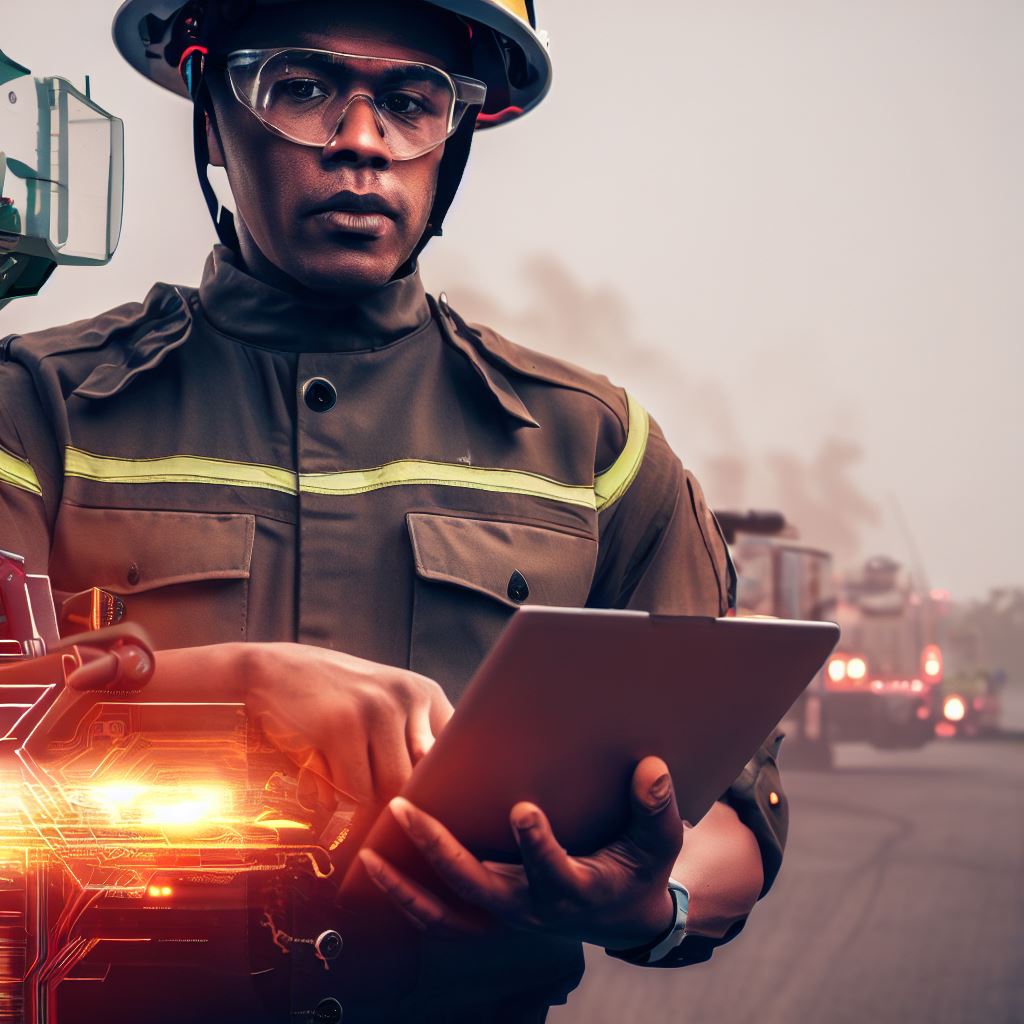Introduction
Explanation of the topic
Technology in fire fighting is revolutionizing the way fires are detected, tackled, and prevented.
From advanced equipment to innovative software, technology plays a vital role in ensuring more efficient and effective fire fighting operations.
Importance of technology in fire fighting
Technology enhances the capabilities of fire fighters by providing them with advanced tools and equipment.
It allows for faster response times, better communication, and improved situational awareness.
By leveraging technology, fire fighters can save more lives and protect property more effectively.
Brief overview of Nigeria’s fire fighting system
Nigeria’s fire fighting system has traditionally relied on manual methods, which can be slow and inadequate.
However, there is a growing recognition of the need to embrace technology in order to enhance fire fighting capabilities.
As a developing country, Nigeria has begun adopting modern technologies such as fire alarm systems, firefighting drones, and satellite imagery for better fire detection and response.
Technology in fire fighting offers significant benefits, especially in countries like Nigeria with densely populated urban areas and inadequate fire safety infrastructure.
By investing in technology, Nigeria can improve its fire fighting capabilities, reduce response times, and minimize the loss of lives and property.
It is essential for the authorities to prioritize the integration of technology into their fire fighting system to ensure a safer future for its citizens.
The current state of fire fighting in Nigeria
Challenges and limitations
- Limited resources and funding affect the effectiveness of fire fighting efforts.
- Inadequate training and lack of awareness contribute to ineffective fire response.
- Poor infrastructure and access make it difficult for fire trucks to reach emergency locations.
- Inefficient coordination between different agencies involved in fire fighting hampers response efforts.
- Lack of public education and fire safety campaigns lead to preventable fire incidents.
Lack of modern equipment and technology
- Outdated fire trucks and equipment hinder efficient fire response and rescue operations.
- The absence of specialized equipment for hazardous substance management poses significant risks.
- Inadequate personal protective gear puts the lives of firefighters at greater peril.
Inefficiencies in response time and effectiveness
- The absence of a centralized emergency hotline results in delayed response to fire incidents.
Despite these challenges and limitations, Nigeria is gradually recognizing the importance of modernizing fire fighting technology and equipment.
The government and relevant authorities have started initiatives to improve the current state of fire fighting in the country.
Efforts such as increasing funding for fire departments, updating fire trucks and equipment, and providing comprehensive training and education for firefighters are being undertaken.
The introduction of modern technologies like drones, thermal imaging cameras, and advanced fire suppression systems can significantly enhance fire fighting capabilities.
These technologies enable quicker fire assessment, better situational awareness, and safer search-and-rescue operations.
Additionally, the implementation of a centralized emergency hotline and improved communication infrastructure will help reduce response time and enhance coordination between different agencies involved in fire emergencies.
Public education campaigns and fire safety awareness programs are crucial in preventing fire incidents and minimizing their impact.
By educating the public about fire safety measures, proper handling of electrical appliances, and the importance of early reporting of fire incidents, the number of preventable fires can be significantly reduced.
Furthermore, collaborative efforts among fire departments, including mutual aid agreements, joint trainings, and sharing of resources, are essential to optimize fire response.
By working together, fire departments can pool their expertise and resources, resulting in improved response time and effectiveness, especially in remote areas with limited resources.
In review, the current state of fire fighting in Nigeria faces various challenges and limitations.
However, with the recognition of the need for modernization, investment in technology and equipment, and improved coordination between agencies, Nigeria can overcome these obstacles.
By prioritizing public education and implementing collaborative initiatives, the country can significantly enhance its fire fighting capabilities, ensuring a safer environment for its citizens.
The Role of Technology in Improving Fire Fighting Capabilities
Advancements in Fire Detection Systems
- Modern fire detection systems utilize state-of-the-art technology to detect fires quickly and accurately.
- Advanced sensors, such as smoke and heat detectors, are integrated into these systems to provide early warnings.
- These systems can detect fires in their early stages, allowing firefighters to respond promptly and prevent major disasters.
- Improved accuracy in fire detection reduces false alarms, saving time and resources for fire departments.
- With the help of advanced technology, fire detection systems can now analyze complex patterns and identify potential fire hazards.
- Artificial intelligence algorithms enable these systems to learn and adapt to new threats, enhancing their effectiveness over time.
Enhanced Communication and Coordination Tools
- Technology plays a vital role in improving communication and coordination among firefighters during emergencies.
- Advanced radios and mobile communication devices allow real-time communication between firefighters on the ground and command centers.
- By sharing critical information instantly, firefighters can make more informed decisions and respond effectively.
- Mobile applications and software solutions streamline communication by providing access to maps, incident reports, and emergency plans.
- These tools enable firefighters to have a better situational awareness and coordinate their efforts efficiently.
- Some communication tools also support video conferencing, enabling remote experts to provide guidance during complex firefighting operations.
Remote-Controlled and Automated Firefighting Equipment
- Remote-controlled and automated firefighting equipment revolutionizes fire suppression operations.
- Drones equipped with thermal cameras and firefighting agents can assess a fire’s intensity and locate hotspots.
- These drones can reach remote or hazardous areas that are difficult for human firefighters to access.
- Autonomous firefighting robots can navigate through dangerous environments and extinguish fires without risking human lives.
- These advanced machines can handle tasks like controlling water flow, cutting off power supplies, and even rescuing trapped individuals.
- By utilizing robotics technology, firefighters can focus on strategic planning and decision-making, maximizing their effectiveness.
Training and Simulation with Virtual Reality and Immersive Technology
- Virtual reality (VR) and immersive technology offer firefighters a realistic training environment to enhance their skills.
- Firefighters can simulate various scenarios, including high-rise emergencies, chemical fires, and hazardous materials incidents.
- Through VR, firefighters can practice decision-making, assess risks, and perform safety procedures in a controlled setting.
- Immersive training experiences help firefighters develop muscle memory and improve reaction times during real emergencies.
- These technologies also allow firefighters to train collaboratively, boosting teamwork and communication skills.
- Virtual simulations reduce the costs associated with traditional training methods while providing a safer learning environment.
In fact, technology has significantly improved fire fighting capabilities in Nigeria.
Advancements in fire detection systems enable early detection, while enhanced communication tools facilitate effective coordination.
Remote-controlled and automated equipment support firefighters in hazardous situations, and virtual reality training enhances their skills.
Embracing technology in fire fighting ensures a more efficient and effective response to emergencies, ultimately saving lives and minimizing property damage.
Read: Sustainability: Eco-Friendly Coating Practices in Nigeria

Implementation of Technology in Nigeria’s Fire Fighting Sector
In order to enhance the effectiveness and efficiency of fire fighting operations in Nigeria, there has been a focus on implementing various technological advancements in the sector.
This has been done through a combination of government initiatives, partnerships, investment in modern equipment and infrastructure, and training programs for fire fighters to adapt to new technologies.
Government Initiatives and Partnerships
The Nigerian government has recognized the importance of integrating technology into the fire fighting sector and has taken several initiatives to achieve this goal.
One such initiative is the establishment of partnerships with international organizations and foreign governments to acquire state-of-the-art fire fighting equipment and expertise.
Through these partnerships, Nigeria has been able to access advanced technologies, such as thermal imaging cameras, aerial drones for surveillance and reconnaissance, and advanced fire suppression systems.
These technologies have significantly improved the capabilities of fire fighters in detecting and extinguishing fires, especially in challenging environments.
Investment in Modern Equipment and Infrastructure
Another crucial aspect of implementing technology in the fire fighting sector is investing in modern equipment and infrastructure.
The Nigerian government has allocated funds to purchase fire trucks equipped with the latest firefighting technologies, such as high-pressure water pumps and foam systems.
Furthermore, the government is also investing in the development of fire stations and infrastructure that can support the deployment of advanced technologies.
This includes establishing dedicated communication systems, integrated command centers, and computerized fire incident management systems.
These investments in modern equipment and infrastructure have not only improved the response time and effectiveness of fire fighters but also enhanced their safety during operations.
Training Programs for Fire Fighters to Adapt to New Technologies
Implementing technology in the fire fighting sector requires a skilled workforce that is capable of effectively utilizing and adapting to new technologies.
To address this, training programs have been introduced to enhance the technical knowledge and skills of fire fighters.
These training programs focus on educating fire fighters about the functionalities and operations of various technological tools and equipment.
They also provide hands-on training on how to use specialized software and systems for fire incident management and analysis.
Moreover, these programs emphasize the importance of continuous learning and updating of skills to keep up with the rapid advancements in fire fighting technology.
In general, the implementation of technology in Nigeria’s fire fighting sector is progressing through various government initiatives, partnerships, investment in modern equipment and infrastructure, and training programs for fire fighters.
These efforts are essential to enhance the capabilities, efficiency, and safety of fire fighting operations in the country.
With continued focus on technological advancements, Nigeria’s fire fighting sector is poised to become a new frontier in utilizing technology for public safety.
Read: Fire Fighting and Community: The Nigerian Perspective
Success stories and case studies of technology in fire fighting
Examples of technology-driven interventions
- Use of drones for aerial surveillance and monitoring of fire incidents.
- Integration of thermal imaging cameras on firefighting helmets for enhanced visibility in smoke-filled environments.
- Deployment of robot firefighters with high-pressure water cannons.
- Implementation of advanced fire suppression systems with automatic detection and extinguishing capabilities.
Positive impact on response time and effectiveness in emergencies
Technological advancements have drastically improved the efficiency and effectiveness of firefighting operations:
- Real-time fire incident tracking systems allow for immediate notification and coordination of resources.
- Quicker identification of fire hotspots enables rapid deployment of firefighting teams.
- High-tech communication devices and GPS systems facilitate better coordination among firefighters.
- Automatic fire suppression systems prevent fires from spreading and minimize damage.
Testimonials from fire fighters and victims
Firefighters and victims alike have shared their experiences and praise for technology in fire fighting:
- “The use of drones has been a game-changer for us. It helps us assess the situation and plan our strategies more effectively.” – Firefighter John Smith
- “I was trapped in a burning building, and the thermal imaging camera on the firefighter’s helmet helped him locate me quickly. It saved my life.” – Jane Anderson, fire incident survivor
- “Since the implementation of advanced fire suppression systems, we have witnessed a significant reduction in fire-related casualties and property damage.” – Fire Chief Sarah Johnson
The impact of technology on fire fighting in Nigeria has been nothing short of revolutionary.
From drones offering a bird’s-eye view of fire incidents to thermal imaging cameras enhancing visibility in smoke-filled environments, these innovations have transformed emergency response.
Robot firefighters, equipped with high-pressure water cannons, tackle hazardous blazes remotely, safeguarding human firefighters.
Advanced fire suppression systems, with automatic detection and extinguishing capabilities, ensure swift fire control, limiting property damage.
Real-time fire incident tracking systems enable rapid mobilization of resources, preventing fires from escalating.
High-tech communication devices and GPS systems improve coordination among firefighters, optimizing resource allocation.
Testimonials from firefighters and victims alike emphasize the life-saving potential of these technologies.
They’ve not only improved response times but also saved lives and reduced property damage. The future of fire fighting in Nigeria looks brighter with continued technological advancements.
Read: Volunteer Fire Fighting: How to Get Involved in Nigeria
Overcoming challenges and the way forward
Addressing financial constraints and budget allocation
One of the major challenges that Nigeria faces in improving its fire fighting technology is the financial constraints and inadequate budget allocation.
Without sufficient funds, it becomes difficult to invest in modern equipment and technology.
To overcome this challenge, the government should prioritize the fire service sector in the national budget.
This would ensure that there are enough funds available for the procurement of advanced fire fighting equipment and the implementation of innovative technological solutions.
Furthermore, the government should explore public-private partnerships to secure additional funding for fire service modernization.
By partnering with private companies, the fire service can access resources that would otherwise be unavailable.
Training and capacity building for fire fighters
Another crucial aspect of improving technology in fire fighting is providing comprehensive training and capacity building programs for fire fighters.
Without proper training, even the most advanced technology would be rendered useless.
Fire fighters should receive regular and up-to-date training on how to effectively use modern fire fighting equipment and technologies.
This would include training on handling specialized vehicles, operating drones for reconnaissance purposes, and utilizing thermal imaging cameras.
In addition, continuous professional development programs should be established to ensure that fire fighters are aware of the latest advancements in fire prevention and suppression.
By investing in the skills and knowledge of fire fighters, Nigeria can enhance its fire fighting capabilities significantly.
Collaborations with international fire fighting agencies
To accelerate the adoption of advanced fire fighting technology, Nigeria should seek collaborations with international fire fighting agencies.
By leveraging the expertise and experience of these agencies, Nigeria can learn best practices and implement them locally.
International partnerships could involve training exchanges, joint research and development projects, and knowledge sharing initiatives.
These collaborations would provide Nigerian fire fighters with exposure to cutting-edge technologies and innovative approaches to fire prevention and control.
International partnerships can lead to the provision of technical assistance and financial support to enhance Nigeria’s fire fighting capabilities.
Through these collaborations, Nigeria can tap into the global fire fighting community and foster a culture of continuous learning and improvement.
Developing a roadmap for continuous improvement and innovation
To ensure the sustained advancement of fire fighting technology in Nigeria, a roadmap for continuous improvement and innovation should be developed.
This roadmap would provide a strategic framework for the adoption of new technologies and the enhancement of existing ones.
The roadmap should include key milestones, action plans, and performance indicators to track progress and ensure accountability.
It should also prioritize research and development efforts to encourage innovation in fire fighting technology.
Furthermore, the roadmap should take into account the specific needs and challenges of the Nigerian context.
By tailoring technological solutions to local conditions, Nigeria can optimize the effectiveness of its fire fighting efforts.
Regular review and evaluation of the roadmap would be essential to incorporate emerging technologies and adapt to evolving threats.
This iterative approach would ensure that Nigeria remains at the forefront of fire fighting technology.
In essence, overcoming the challenges faced in enhancing fire fighting technology in Nigeria requires a multi-faceted approach.
Adequate budget allocation, training and capacity building for fire fighters, international collaborations, and a roadmap for continuous improvement are all necessary for Nigeria to achieve its potential in the field of fire fighting technology.
Read: Government Support: Policies for Coating Techs in Nigeria
Conclusion
Technology plays a vital role in enhancing fire fighting capabilities.
The use of advanced tools and equipment improves efficiency, safety, and effectiveness in dealing with fire incidents.
Nigeria, with its growing economy and technological advancements, has the potential to become a leader in technology-driven fire fighting.
However, it is crucial to encourage further research and investment in this field.
By supporting innovation and development, we can address the unique challenges faced by Nigeria in combating fires and save more lives and properties.
Increased collaboration between the government, private sector, and research institutions will drive progress and result in cutting-edge solutions for fire emergencies.
Let us recognize the significance of technology in fire fighting and harness Nigeria’s potential to revolutionize this sector.
Together, we can create a safer environment and protect our communities from the devastating impacts of fires.




